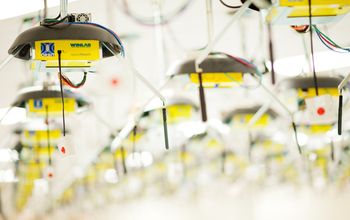Page 10770
Jul 13, 2016
Soldiers Could Soon Be Wearing Body Armour Made From Genetically Engineered Spider Silk
Posted by Karen Hurst in categories: bioengineering, genetics
Jul 13, 2016
Why diamonds could be technology’s best friend
Posted by Karen Hurst in categories: biotech/medical, electronics
When we look at the huge tech and industrial revolution that is just on the verge of happening due to QC and Medical technologies; synthetic diamonds will be a central piece of this story. I hope Intel, Nvidia, HP, Xerox, Apple, etc. all are assessing how they can either produce or partner with producers of synthetic diamonds. Printer companies could be big players in the mass production story of Synthetic Diamonds; and partnerships between Intel and HP or Intel and Xerox could prove to be fruitful.
COULD synthetic diamonds be key to developing the advanced electronics of tomorrow? A company crowd-funding on Cambridge’s SyndicateRoom thinks so.
Evince is looking to raise £650,000 to develop a working prototype of its new semi-conductor, which it says has the potential to perform 100 times better than silicon.
Continue reading “Why diamonds could be technology’s best friend” »
Jul 13, 2016
Allen Brain Observatory peers into the minds of mice as they watch movies
Posted by Karen Hurst in categories: entertainment, neuroscience

The Allen Brain Observatory is open for business, revealing what’s running through the mind of a mouse as it sees patterns of light and dark, pictures of butterflies and tigers – or even the opening scene of Orson Welles’ 1958 classic film, “Touch of Evil.”
The online repository of 30 trillion bytes’ worth of brain-cell readings represents the latest scientific offering from the Allen Institute for Brain Science, funded by Microsoft co-founder Paul Allen. It follows through on a $300 million pledge that Allen made more than four years ago.
Continue reading “Allen Brain Observatory peers into the minds of mice as they watch movies” »
Jul 13, 2016
Collapse: Has quantum theory’s greatest mystery been solved?
Posted by Sean Brazell in categories: particle physics, quantum physics
Our best theory of reality says things only become real when we look at them. Understanding how the universe came to be requires a better explanation.
By Jon Cartwright
WHERE, when you aren’t looking at it, is a subatomic particle? A quantum physicist would probably answer: sort of all over the place. An unobserved particle is a wisp of reality, a shimmer of existence – there isn’t a good metaphor for it, because it is vague both by definition and by nature. Until you do have a peek. Then it becomes a particle proper, it can be put into words, it is a thing with a place.
Continue reading “Collapse: Has quantum theory’s greatest mystery been solved?” »
Jul 13, 2016
New concept would have an assembly robot build an extremely large telescope in space
Posted by Klaus Baldauf in categories: robotics/AI, space
Enhancing astronomers’ ability to peer ever more deeply into the cosmos may hinge on developing larger space-based telescopes. A new concept in space telescope design makes use of a modular structure and an assembly robot to build an extremely large telescope in space, performing tasks in which astronaut fatigue would be a problem.
The robotically assembled modular space telescope (RAMST) design is described by Nicolas Lee and his colleagues at the California Institute of Technology and the Jet Propulsion Laboratory in an article published this week by SPIE, the international society for optics and photonics, in the Journal of Astronomical Telescopes, Instruments, and Systems (JATIS).
Ground-based telescopes are limited by atmospheric effects and by their fixed location on the Earth.
Jul 13, 2016
This Company Users Lasers to Relieve Pain and Treat Cancer
Posted by Shailesh Prasad in categories: biotech/medical, business, education
Roger Dumoulin-White, president and CEO of Theralase Technologies, explains his company’s two divisions: the currently operating therapeutic laser division and the anti-cancer division. The company’s TLC-1000 laser is used for pain relief, tissue healing and more, and upwards of 1,200 medicial facilities worldwide use the device. The next-generation TLC-2000 laser was recently FDA-approved. At this time, Theralase Technologies is conducting clinical trials for photodynamic compounds that help to destroy cancer cells.
Click play to learn how these new technologies have the potential to revolutionize cancer treatment.
Entrepreneur Network is a premium video network providing entertainment, education and inspiration from successful entrepreneurs and thought leaders. We provide expertise and opportunities to accelerate brand growth and effectively monetize video and audio content distributed across all digital platforms for the business genre.
Continue reading “This Company Users Lasers to Relieve Pain and Treat Cancer” »
Jul 13, 2016
Amazing postcards of what people in 1900 thought the future would look like
Posted by Shailesh Prasad in category: futurism
Jul 13, 2016
Kraig Biocraft Laboratories Announces Contract with U.S. Army to Deliver Dragon Silk
Posted by Klaus Baldauf in categories: bioengineering, military
ANN ARBOR, Mich., –July 12, 2016- Kraig Biocraft Laboratories, Inc. (OTCQB: KBLB) (“Company”), the leading developer of spider silk based fibers, today announced that it has received a contract valued at up to $1.0 million, if the option phase is awarded, for the development of high performance fibers for protective apparel applications. Under the fully funded base effort, valued at $99,962, the Company will deliver ballistic shoot packs constructed from its proprietary Dragon Silk™ material for performance testing. These shoot packs will be tested and evaluated for critical Soldier protective applications including ballistic impact. If awarded, the option phase will significantly expand this work with the US Army.
“Dragon Silk scores very highly in tensile strength and elasticity, which makes it one of the toughest fibers known to man and the ideal material for many applications,” stated Jon Rice, COO. “Providing material for this ballistic shoot pack initiative is an important next step for Kraig and spider silk. This contract reinforces the many significant potential applications for recombinant spider silk. Today is a great day for spider silk.”
“We’re proud to be working with the Department of Defense to assess the exciting potential of spider silk for military applications,” stated Kim K Thompson, CEO and founder of Kraig Biocraft Laboratories. “We are honored that the U.S. Army has selected us for this program. This effort will provide Kraig Labs with the opportunity to validate our longstanding belief that spider silk technology has had an incredible potential for protective and lifesaving materials and expand our ability to design and engineer innovative materials solutions.”
















